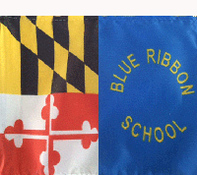|
Six public schools this
week were selected as 2016 Maryland Blue Ribbon Schools.
The schools are:
|
Arnold Elementary School, Anne Arundel County
Pasadena Elementary School, Anne Arundel County
George Washington Carver Center for Arts & Technology, Baltimore County
Hereford High School, Baltimore County
North Harford Elementary School, Harford County
White Marsh Elementary School, St. Mary’s County
|
|
 |
“The Maryland Blue Ribbon Schools
represent the outstanding accomplishments of public schools throughout our
State,” said Interim State Superintendent of Schools Jack R. Smith. “The
students, teachers, administrators, and communities work together to make these
schools something special, and they deserve recognition and celebration.”
The schools are recognized on the
basis of rigorous State and national requirements for high achievement and
significant improvement. The students in each of these schools are high
achievers in reading and mathematics, and several of these schools also serve a
significant number of economically disadvantaged students and students for whom
English is a second language.
The schools will be invited by the
U.S. Department of Education to apply to be National Blue Ribbon Schools. With underwriting and gift sponsors, each
school will receive a Maryland Blue Ribbon Flag, a $2000 monetary prize, $1000
of office supplies, interactive technology equipment, and a school Congratulations Party. Underwriting sponsors include BGE, Comcast,
Dimension U, Mrs. Fields, NTA Life, Rudolph’s Office Supply, SMART
Technologies, and State Farm Insurance.
A dinner in Annapolis will be held in honor of the winning schools this
coming spring, as each Blue Ribbon School will be honored by the Maryland House
of Delegates and the Senate.
A gallery of the new Blue Ribbon
recipients can be found on the MSDE
Facebook page.
Data
released this month for Maryland’s new elementary and middle school assessments set
a new baseline that will help to gauge whether students are on track for the
next grade. The data were presented on Dec. 8 to the Maryland State Board of
Education.
Nearly
40 percent of students in grades 3-8 taking the PARCC English Language
Arts/Literacy Assessments last spring scored at a Level 4 and 5 combined – the
two highest levels on the PARCC five-point score scale. Nearly 30 percent of
elementary and middle school students attained Level 4 and 5 combined in the
mathematics assessment. For students in
grades 3 through 8, achieving Level 4 or 5 indicates readiness for coursework
in English and math at the next grade, with the goal of preparing students to
enter college or career upon graduation.
The scores required to meet these thresholds were determined over the
summer by Maryland educators and their peers around the country.
“These
initial results provide a new springboard for Maryland students, as we continue
our work to better prepare them for what lies ahead,” said Interim State
Superintendent of Schools Jack R. Smith.
“We have set the bar high, and this data reflects that. These results
should be viewed in combination with other measures when assessing student
progress.”
The
initial score results for elementary and middle school mirror those released
earlier for the PARCC high school assessments in English 10, algebra I and
algebra II. Nearly 40 percent of high
school students taking the PARCC English 10 assessment last spring scored at a
Level 4 and 5 combined, while more than 30 percent of high school students
attained Level 4 and 5 combined in algebra I.
More than 20 percent of students scored at a Level 4 and 5, combined, on
the new algebra II test.
Test
results show some variations between grades.
Eighth grade English scores were the best, with 40.4 percent of students
scoring a 4 or 5, while 6th grade scores were the lowest, with 36.1
percent of students scoring a 4 or 5.
Variations were more pronounced in mathematics, where 36.4 percent of 3rd
graders scored 4 or 5 in mathematics, but just 21.3 percent of 7th
graders scored a 4 or 5.
Significant
score differences exist between student subgroups. For example:
PARCC
Mathematics, Grades 3-8: Overall, 29 percent of students scored at a
level 4 and 5 combined; African American students, 13 percent scored at a level
4 and 5; Asian students, 60.7 percent scored at a 4 and 5; Hispanic students,
16.1 percent scored at a 4 and 5; White students, 42.4 percent scored at a 4
and 5; and students of Two or More Races, 34.3 percent scored at a 4 and 5.
Among
students receiving special services, 5.5 percent of special education students
scored at a level 4 and 5 combined; 4.7 percent of limited English proficient
students scored at a 4 and 5; and 12.9 percent of students receiving free or
reduced price meals (the federal proxy for poverty) scored at a 4 and 5.
PARCC
English Language Arts/Literacy: Overall, 38.9 percent of students scored at a
level 4 and 5 combined; African American students, 22.7 percent scored at a 4
and 5; Asian students, 65.3 percent scored at a 4 and 5; Hispanic students,
24.4 percent scored at a 4 and 5; White students, 52.4 scored at 4 and 5; Two
or More Races, 46 percent scored at a 4 and 5.
Among students receiving special services, 6.3 percent of special
education students scored a 4 and 5 combined; 3.1 percent of limited English
proficient students scored a 4 and 5; and 20.3 of students receiving free or
reduced price meals scored a 4 and 5.
Results
from the PARCC assessments will not be used for student or educator
accountability this year. In the coming
months, the State Board will determine how the data will be used going forward.
Complete PARCC elementary and middle
school results for Maryland students is available at MdReportCard.org.

Interim State Superintendent of Schools
Jack R. Smith
|
Say
goodbye to No Child Left Behind and hello to the Every Student Succeeds Act.
The
reauthorization of the Elementary and Secondary Education Act completed last week was long overdue,
and we are delighted a long-term, stable, federal education policy is now in
effect. The new Every Student Succeeds Act provides important flexibility to
states and local school systems and will support us as we continue to prepare
our students to meet the challenges of an increasingly competitive global
economy.
Maryland
has long believed in the importance of strong accountability as a method of
strengthening student achievement and moving our schools forward. With a continued requirement to provide
disaggregated student performance data, the new law will continue to shine a
light on the academic achievement of every Maryland student, while providing
the State and its 24 local school systems the flexibility to implement
improvement strategies that best meet the needs of individual schools.
We
appreciate the support of the Maryland delegation as the bill moved through
Congress, and particularly the work of Senator Mikulski, who successfully
fought efforts to change the funding formulas for aid designated for schools
serving Maryland’s economically disadvantaged students. Without her dedicated work, Maryland schools
may have lost as much as $40 million.
* * *
MSDE has announced its call for
nominations for the ninth annual Maryland Parent Involvement Matters Awards
(PIMA). The unique awards program honors
parents and others with legal responsibility for a child whose exemplary
contributions to public education have led to improvements for Maryland’s
public school children, teachers, schools, programs and/or policies.
Volunteers lie at the heart of any
school's accomplishments. This awards
program puts a spotlight on some amazing work by Maryland parents to strengthen
student learning and the school community.
When I visit a great school, I know parents and guardians have worked
collaboratively with educators to make it a success.
Take a few moments over the winter
break to think about those parents who make your school and school system a
better place to teach and learn. Then
nominate one of those deserving individuals for this wonderful recognition.
2016 Maryland Parent Involvement
Matters Award nominees must be parents or legal guardians of children attending
Maryland public schools, and cannot be employees of MSDE or the Maryland public
school system. Twenty four semifinalists will be selected – one parent from
each of the 23 Maryland counties and one from Baltimore City. Of the semifinalists, five finalists and one
statewide winner will be named at an award celebration hosted by in the spring
of 2016.
Nomination forms are currently
available and can be downloaded at www.MarylandPublicSchools.org/pima. Nominations must be postmarked by Friday,
January 29, 2016.
 |
|
Julie Harp - Presidential Awardee
Julie Harp, 8th grade teacher at Mace's Lane ES in Dorchester County,
talks about the experience of being nominated, applying for, and winning
one of two awards in Maryland for Excellence in Mathematics and Science
Teaching.
|
 |
|
James Schafer - Presidential Awardee
James Schafer, Physics teacher at Montgomery Blair HS, talks about
winning the Presidential Award for Excellence in Mathematics and Science
Teaching, about the nomination and application process, and the need
for more STEM teachers.
|
 |
|
Why Measure Progress?
Greg Pecoraro, Executive Director of the BWI Business Partnership talks
about why it is important students be tested and measured.
|
January 13 - 2016 Maryland General Assembly Opens
January 26 - Maryland State Board of Education Meeting
President Signs ESSA
Education Week
Maryland PARCC Tests Released
WBAL-TV
Commentary: Don’t Shoot the PARCC Messenger
Baltimore Sun
Keiffer Mitchell Calls on Business to Help Solve Achievement Gap
Baltimore Business Journal
|